The Association for Mormon Letters’ AML Awards were presented online on July 23, 2022. You can watch the awards ceremony, emceed by Eric W. Jepson, and featuring remarks from many of the winners, at YouTube here. You can also see many of the award winners reading from their award-winning works here. Below is each award winner, along with the award citation written by the judges.
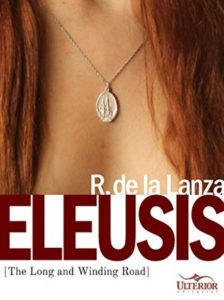 Novel
Novel
R. de la Lanza. Eleusis:The Long and Winding Road. Intendencia de las Letras/Ulterior Editorial
R. de la Lanza’s Eleusis: The Long and Winding Road offers a sweeping, multi-generational portrait of Mormon life in Mexico during the twentieth century. (It is written in Spanish, English-language readers will be happy to know that James Goldberg translated the first two chapters for Dialogue last year.) The novel has no single protagonist but opens by depicting a man named Moroni receiving a phone call with the news that his best friend, a lifelong and faithful Latter-day Saint, has died. Although Moroni has not been to church in years, he is invited to help dress his friend in temple robes before burial. The scene’s frankness about sexuality (Moroni receives the phone call while in bed with a woman he barely knowns) and the material details of Mormon life (he punctuates his decision to go help with the burial by digging his temple garments out of a drawer and putting them back on) presage the novel’s distinctive vision of faith as something lived and embodied, not merely believed or contemplated.
Eleusis moves backward and forward in time, and laterally among characters in short narrative episodes. As it proceeds, these episodes build on one another and become entangled, and readers view the astonishing scope of modern, Mexican Mormon experience, from the violent upheaval of the Revolution to the schism of the Third Convention movement, to the social and institutional influence of the Benemérito school run by the church in Mexico City (closed in 2013). We see characters fall in love, have children, cheat on each other, divorce, and reconcile. We see them alternately leave the faith, persist in the faith, and return to the faith, and then we see their children and grandchildren face similar choices. Remarkably, the novel withholds judgment about these choices. It invites us to understand, as the title suggests, each individual’s journey as complex and incomplete, and through that understanding to regard them with compassion.
De la Lanza’s novel provides an invaluable perspective on Mormonism from outside the United States, and it does so through lyrical language, economical character development, and complex narrative form. We are thrilled to award the 2021 AML Novel Award to Eleusis.
Other finalists:
The Jupiter Knife by D. J. Butler and Aaron Michael Ritchie
Picnic in the Ruins by Todd Robert Petersen
Noria by Juan Antonio Santoyo
 Short fiction
Short fiction
Mario R. Montani. “Y no preguntes mas . . .” Irreantum 17:2. In Spanish. English translation, “So Ask no More . . .“, translated by Gabriel González.
Mario R. Montani’s “Y no preguntas mas . . .” is an extraordinary work of speculative fiction. Hailing back to C.S. Lewis’s masterpiece, The Screwtape Letters, Montani introduces readers to Amaliel: one of those who followed Lucifer in opposition to the Father’s plan of salvation. As a member of the “punishing brethren” Amaliel is tasked with destroying the marriage of a young couple—Pablo and Eliza—who have recently experienced a miscarriage. To his utter surprise, his attempts fail as he begins to feel the intensity of feeling that these mortals have for one another and the child they have lost, and Amaliel finds himself doubting the master plan of “Brother Lucifer” and aching, instead, to join the cause of Christ.
Montani’s tale of this wavering soul winds itself to an astonishing conclusion, and offers a genuinely fresh take on issues related to the plan of salvation, the fall of Adam and Eve, and the depth and breadth of hope the atonement of Jesus Christ provides even the most sinful of sinners. Through Amaliel’s singular voice, readers will recognize the range of intense emotion that accompanies the requirements of that most common religious experience: repentance. At its core, “Y no preguntas mas . . .” is a contemporary offering of everlasting hope for one sincerely seeking a mighty change of heart. It is glorious.
Other finalists:
Riley Clay. “Good Shepherd Church”
James Goldberg. “Between Glory and Ruin”
Rachel Helps. “Skillick’s Bride”
Spencer Hyde. “The Wall”
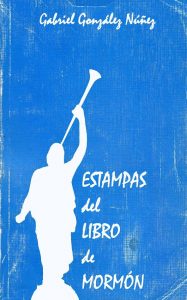 Special Award in Fiction
Special Award in Fiction
Gabriel González Núñez. Estampas del Libro de Mormón
Gabriel González Núñez’s Estampas del Libro de Mormón is a collection of nearly thirty biographical sketches of characters from The Book of Mormon, inspired by the Uruguayan poet Juana de Ibarbourou’s Estampas de la Biblia (1934), a collection of forty brief dramatic monologues featuring characters from the Old Testament. Divided into three parts—“Generations,” “The Old Country,” and “The Great Nephite Nation”—Estampas invites us to listen to the voices of major and minor Book of Mormon characters and by so doing enrich our understanding of their inner lives, personal challenges, and hopes for their posterity.
González Núñez’s imaginative sketches are unique, insightful, and beautifully written. Each sketch provides a richly emotive narration followed by the name of the speaker and a label of identity. From Lehi the visionary to Abish the Servant, to Gadianton the robber, González Núñez manages to cast new light on the heretofore-unconsidered elements of these Book of Mormon personalities. What is most impressive, however, is the distinctiveness of each included voice. Though the structure of each sketch is similar, the mood and tone shifts from page to page, story to story, person to person. With Enos, we feel the spiritual potential of the forest. With Coriantumer, the physical and spiritual exhaustion of living with the devastation of post-war solitude. González Núñez masterfully reveals the conversion of King Lamoni, and a tender portrayal of a discouraged Corianton, who, despite his greater desires, continues to cave to temptation.
Those who read González Núñez’s slender volume should not be deceived—it packs a spiritual punch. From the holy quietude of Enos’ forest to the ferocity of Teancum’s battlefields, Estampas del Libro de Mormón will take its readers from valley to mountaintop, and leave them, like Samuel the Lamanite, searching the stars.
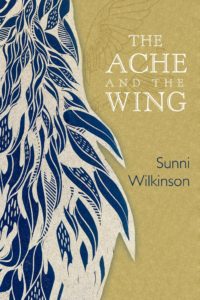 Poetry
Poetry
Sunni Brown Wilkinson. The Ache and The Wing. Sundress Publications
In her moving chapbook, Sunni Brown Wilkinson confesses, “I could never be a prophet. So much sad truth to say.” The confession comes in the midst of a little white lie to her son about a pet parakeet who had escaped from its cage and flown away during a cold November: “I lied to my son. I said he was okay.” But it is Wilkinson’s brutal honesty, not this casual deception, that fills her collection of poems about death and loss. She writes of a Latter-day Saint bishop who testifies of the resurrection while grieving the deaths of his own son and father in a collapsed mine, reassuring his ward members of the promise of renewed life while silently thinking “of bodies that break, that bear each other, / that hold one another in dark places. Of the God / who sees it all.” She writes in the voice of her husband’s dying grandfather, whose mourning for the loss of his farm (“Goodbye farm—my life’s love”) reflects a deeper grief for the loss of his parents:
Every stick I lifted from the grass, each Spring’s
first mowing, each fence post mending
a reaching
for my parents’ vanished hands.
The painful loss of children and parents finds its fullest expression when Wilkinson writes of her own stillborn child, whose absence permeates the entire volume. Poems that begin with descriptions of mundane life in rural Northern Utah—the blaring of the announcer on rodeo night, a friendly reminder at a Conoco station not to feed the coyotes, the sounds of AM radio in the garden to keep the deer away—ultimately find their way to the “body we held briefly and let go” of Wilkinson’s son. “Near the end of June the baby arrives but he is dead already. We hold the husk of him in a white blanket before the mortician comes. No blood hum or cry song, just silence.” All of the poems struggle to find meaning in the “darkest hallelujah” of this painful loss, but they often end with the bleak realization that “Sometimes a child dies / and living things are ugly.” Ultimately, though, these poems are like the pet parakeets who keep singing after their companion has flown off to the frigid death whose “sad truth” Wilkinson could never express to her living son: “Like God, they make music out of nothing.”
Other finalists:
Mark D. Bennion. Beneath the Falls
Jared Pearce. Down Their Spears
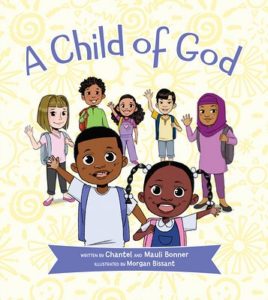 Picture Book
Picture Book
Chantel Bonner, Mauli Bonner, and Morgan Bissant. A Child of God. Shadow Mountain/Ensign Peak
Picture books are intended for small children and as such use simple language to express ideas. However, it is a mistake to assume that simple language cannot express complex ideas or that small children only encounter small problems.
A Child of God is a picture book that tackles the complex issue of race and representation in the Christian church and in religious art. In the book, which is told in rhyme, a Black boy and girl ask their parents what it means to be made in God’s image. Their parents explain that God made us different colors the way He made different colors of flowers, but we are all still His children. The children follow up by asking why they don’t resemble a painting of blonde-haired angels. Their parents tell them that angels look like everyone, not just like one person’s artistic interpretation, and encourage them to draw their own pictures of angels.
The authors are a married couple, Chantel and Mauli Bonner, and the illustrations are by Morgan Bissant. All three are Black, and it is evident that the message of this beautiful, thoughtful book is informed by real conversations they have had in their families or communities. While Christian families of color will welcome the publication of this book, white adults may see it and think that it is not “for” them or their white children. This is not true. It is just as important that white families learn about these ideas as a way to examine privilege and counteract bias. We cannot be truly united in faith until we learn to appreciate the diversity of all members of the body of Christ.
Other finalists:
The Boy and the Sea by Camile Andros and Amy June Bates
We Believe: Illustrated Articles of Faith by Annie Soon
Thankful by Elaine Vickers and Samantha Cotterill
10 Little Disciples by Sierra Wilson
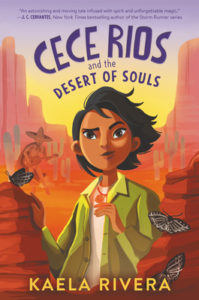 Middle Grade Novel
Middle Grade Novel
Kaela Rivera. Cece Rios and the Desert of Souls. HarperCollins
Kaela Rivera’s Cece Rios and the Desert of Souls is a compelling middle grade fantasy novel about a girl who must partner with a criatura and enter the bruja fights in order to save her sister. It is a story about friendship and family, loyalty and love, and most of all, about holding on to your beliefs. Cece faces hard, near impossible choices, and yet she always shows courage and willingly sacrifices for others.
Rivera has crafted a rich story permeated by the tension of life and survival in a desert landscape which feels reminiscent of certain regions of Mexico. The mythological landscape and legends, which are inspired by Mesoamerican folklore, are intertwined seamlessly with the plot and characters. Secondary characters, like Coyote, must deal with their own past choices and the consequences of these decisions on the present day. Even though the primary way in which humans interact with criaturas is through control and domination, Cece respects everyone’s autonomy and agency, even that of her enemies. She also refuses to label the criaturas as evil or frightening, simply because that is the way they have traditionally been perceived by her community. The book contains vivid narration and compelling imagery, with many twists and turns. Cece Rios and the Desert of Souls makes a unique contribution to both Mormon literature and middle grade literature more generally, and is sure to evoke a sense of wonder in middle grade readers.
Other finalists:
Breathing Underwater by Sarah Allen
Horace & Bunwinkle: The Case of the Rascally Raccoon by P.J. Gardner (illustrated by Dave Mottram)
Friends Forever by Shannon Hale (illustrated by Leuyen Pham)
Tips for Magicians by Celesta Rimington
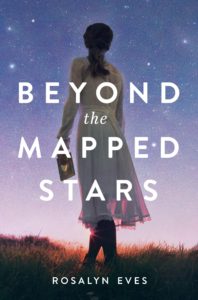 Young Adult Novel
Young Adult Novel
Rosalyn Eves. Beyond the Mapped Stars. Knopf
Seventeen-year-old Elizabeth Bertlesen, the protagonist of Rosalyn Eves’ Beyond the Mapped Stars, is a young Mormon girl living in Monroe, Utah in the 1870s. Her days are spent helping her mother with the family, but in her heart she loves the night skies and longs to become an astronomer. When she’s called away from her small town to help her pregnant older sister, Elizabeth eventually works her way to Denver, Colorado on the eve of a total solar eclipse. While there, she meets a group of women scientists who have come to study the eclipse and who give her a vision of who she could be if she followed her scientific ambitions–a vision that only inspires more questions about her future. As she pursues the chance to study the eclipse, she struggles to navigate doubts and conflicts about her faith and her role within that faith, her duty to her family, and her desire to realize her ambitions to study the stars.
Eves’ vivid and lyrical writing creates an engaging world populated with interesting and unforgettable characters. Elizabeth is especially well-drawn and readers (young women in particular) will see themselves reflected in her experiences. Her struggles to reconcile her ambition to study science with her faith and her family’s expectations are more relevant today than ever before, and Eves explores these tensions authentically and movingly. In the hands of this skilled writer, Elizabeth’s journey entertains and educates at the same time as it inspires.
Other finalists:
A Sisterhood of Secret Ambitions by Sheena Boekweg
Where I Belong Marcia Mickelson
Fadeaway by E. B. Vickers
In the Wild Light by Jeff Zentner
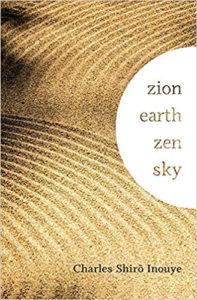 Creative Nonfiction
Creative Nonfiction
Charles Shirō Inouye. Zion Earth, Zen Sky. Neal A. Maxwell Institute
Charles Inouye’s Zion Earth Zen Sky is a strikingly original and beautiful book, a tour de force of wisdom and insight. A candid autobiography and a powerful work of religious and cultural criticism, Zion Earth Zen Sky blends eastern and western sensibilities as well as rhetorical forms like personal narrative, haiku poetry, and syncretic commentary. Beginning with his upbringing in a Japanese family building a new life on a Utah farm, Inouye recounts key events that have shaped his life as a Latter-day Saint and accomplished scholar of Japanese literature at Tufts University. He also shares poignant details about life struggles, opens windows onto his personal relationships, and offers powerful (and often brilliantly counterintuitive) perspectives on important aspects of Latter-day Saint moral and theological life. Zion Earth Zen Sky is a generational book that will become – indeed, already is – a landmark of Mormon letters.
Other finalists:
Blossom as the Cliffrose: Mormon Legacies and the Beckoning Wild edited by Karin Anderson and Danielle Dubrasky
Where the Soul Hungers: One Doctor’s Journey from Atheism to Faith by Samuel M. Brown
Scrupulous: My Obsessive Compulsion for God by Taylor Kerby
Ninety-Nine Fire Hoops by Allison Hong Merrill
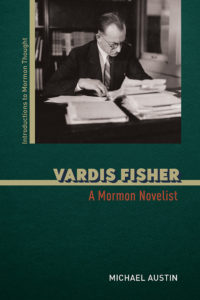 Criticism
Criticism
Michael Austin. Vardis Fisher: A Mormon Novelist. University of Illinois Press
Michael Austin’s monograph is a remarkable feat in the field of Mormon literary criticism. The brevity of this biography belies the depth of its contribution. Much as Fisher himself pursued an “intellectual genealogy” of Mormon doctrine and culture in his fiction, Austin establishes the lineage of Mormon letters, which first entered the mainstream of American book publishing with Fisher. This treatment of Fisher’s life and work delivers a richly detailed understanding of the genesis of Mormon literature and the tensions that surround its development. Opening a space between “frontier adventures and faith promoting stories” produces a body of literature which wrestles with religious ambitions, contradictions, and failures, and reveals a world where writers who insist on thinking about the personal and communal implications of their belief system are left orphaned, like the pilgrims in Melville’s epic poem Clarel, in a world soaked in religious fervor. As Austin suggests, Fisher and others in this emerging literary tradition understand the need for redemption but are repulsed at the “reduction of the moral quest.” This biography is meticulously researched and presents original analysis of the historical polemics around Fisher’s status as a “Mormon” author. Austin evaluates Fisher’s Mormon background and the Mormon themes in his Western novels and the epic “Testament of Man” series with even-handed and engaging prose, which he peppers with both humor and insight that rises to the level of epiphany. He recognizes and reveals the many scars that marked Fisher from his deep encounters with Mormon life and doctrine, including his impulse to make his final epic a work of secular scripture. As an inaugural volume to the University of Illinois Press’s series “Introductions to Mormon Thought,” this excellent work shows how effective this format can be in reassessing individual contributions to Mormon intellectual history. Austin’s comprehensive study invites scholars to further engage with Fisher, the radical prophet of Mormon literature, and other Mormon writers who are committed to the “deep and quiet holiness of work,” particularly the work of religious self-examination through fiction. As such, it makes a singular contribution to the field of Mormon letters, not only in promoting the critical study of Mormon writers and literature, but in illuminating the place of those writers in the larger intellectual landscape of the nation in the early twentieth century.
Other finalists:
Barrett Burgin. “The Case for Resurrection: A Mormon Movie Manifesto.”
Amy Easton-Flake. “Theologies of the Afterlife in Mormon Women’s Late-Nineteenth-Century Poetry.”
Adam McClain, editor. “Mormonism in SF,” for SFRA Review
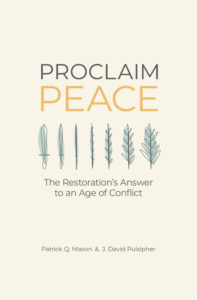 Religious Nonfiction
Religious Nonfiction
Patrick Q. Mason and J. David Pulsipher. Proclaim Peace: The Restoration’s Answer to an Age of Conflict. Neal A. Maxwell Institute
In an unprecedented gathering of insightful and well-written works of religious nonfiction, Patrick Q. Mason and J. David Pulsipher’s Proclaim Peace: The Restoration’s Answer to an Age of Conflict is a standout. The book speaks directly to our conflict-ridden world, is well-grounded in solid academic scholarship, solid logic, persuasive examples, and the best religious thinking on peace. It is both readable and philosophic, approachable by the lay member and the trained thinker. Disciples of the Prince of Peace will resonate with the goals of Proclaim Peace, and even readers who disagree will feel invited to join in meaningful conversation about violence in the modern world. That is perhaps one of the great accomplishments of this timely book: in an age when name-calling is a substitute for conversation, and fake news and sloganizing stand in the place of real dialogue, people who disagree just may join the ongoing discussion about violence. If they do, it will be because these authors’ goodwill and elegant style demonstrates respect for their audience, their topic, and their God. With generosity in perspective, humility in thought, and charity for readers, the authors of Proclaim Peaceinvite readers to communicate about the violence that has threatened the fabric of society since Cain slew Abel. The invitation is, itself, a demonstration. Patrick Mason and David Pulipher’s Proclaim Peace should be read for many reasons, but—at very least—it should be read for this one: these authors practice what they preach.
Other finalists:
Terryl L. Givens. Stretching the Heavens: The Life of Eugene England and the Crisis of Modern Mormonism
Patrick Q. Mason. The Restoration: God’s Call to the 21st Century World
Joseph M. Spencer. The Anatomy of Book of Mormon Theology, Vols. 1 and 2
Shawn Tucker. Humility: A Practical Approach
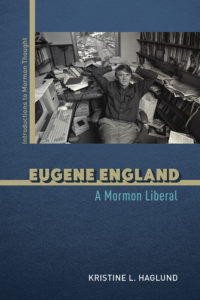 Special Award in Nonfiction
Special Award in Nonfiction
Kristine L. Haglund. Eugene England: A Mormon Liberal. University of Illinois Press
Eugene England was the last Mormon liberal of his kind. At least, that’s one of Kristine Haglund’s many contentions in her invigorating and awakening book on England’s life and thinking. The inaugural text in the University of Illinois Press’s Introductions to Mormon Thought, Haglund’s book outlines how England bridged early and contemporary Mormonism: born in the farmland of Idaho, England kept in close contact with many apostles and Church leaders, building an intimate relationship with authorities that is hard to fathom today. Haglund shows how England’s thought developed, his Mormon faith always influencing—even being the catalyst to—his liberal politics and activism.
The book is not simply a biography of a man but an engagement with his work, his words, and his legacy. Through her careful analysis of the corpus of England’s work, Haglund welcomes England’s thinking into the twenty-first century, inviting a new generation of Mormon thinkers, activists, theologians, and historians to learn more about one of the greatest Mormon liberal thinkers of the twentieth century, and to follow his example of charitable dialogue, candor, and tolerance. Because of its inauguration of a series of texts that will expand Mormon letters, its excellence in criticism and religious thought, and its welcoming and inviting writing, the Association for Mormon Letters awards Kristine Haglund a special award for her work on Eugene England: A Mormon Liberal.
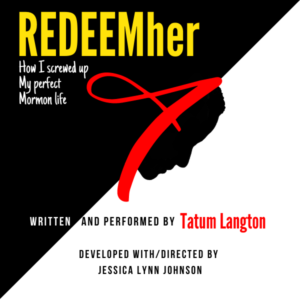 Drama
Drama
Tatum Langton. REDEEMHer: How I Screwed up my perfect Mormon life
Tatum Langton’s solo play REDEEMher is an intimate, funny, no-holds-barred autobiographical examination of one woman’s faith journey in the context of her “perfect” Mormon marriage. Two Latter-day Saint young adults meet, share their plans and dreams with each other, fall in love, and are sealed in the temple. Soon, plans change, dreams are abandoned, they fight, grow apart, and eventually both find comfort and connection with others. Tatum is overcome with remorse and guilt and a driving desire to fix their relationship, but learns that forgiveness, redemption, and healing sometimes require letting go and moving on instead. The framework of the story is not unique; Langton’s openness, vulnerability, and grace for all involved, however, sets REDEEMher apart in refreshing ways.
Latter-day Saint audiences will find much about Tatum’s character and story familiar, yet the play is structured to be easily accessible to audiences not familiar with the language and culture of Mormonism. We meet older and younger versions of Tatum, her husband, her friends and acquaintances, her bishop, and even different inner aspects of Tatum herself as she explores what is happening in her marriage, why it’s so different from her expectations, how she is changing, and what it means to be true to her faith and herself. Langton is honest and vulnerable, and a touch irreverent, bluntly addressing issues of sex and sexuality, gender roles, and cultural expectations that chafe. She does not treat the faith with kid gloves, instead trusting her audience with an unflinching view of her whole story, both the bad and the good. And there is so much good. The kindness of family members and friends, the compassion of the bishop, the development of Tatum’s personal relationship with God, the growth and maturity and redemption that comes as Tatum forgives herself and regrounds herself in her faith on her terms.
She has performed the play at Hollywood Fringe Festival, August 2021 and the Santa Monica Binge Free Festival, November 2021. It will be performed at the Edinburgh Fringe Festival, August 2022.
In REDEEMher, Langton bares her soul, offering herself the grace, understanding, and compassion that her younger self needed and that, by extension, we all need. We are honored to name REDEEMher as the winner of the 2021 AML Drama Award.
Other finalists:
King Stag by Janine Sobeck Knighton
Gin Mummy by Melissa Leilani Larson
1820: The Musical, book by George Nelson
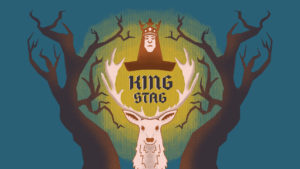 The Drama Award judges also wrote a citation for one of the finalists, King Stag.
The Drama Award judges also wrote a citation for one of the finalists, King Stag.
King Stag is a delightful escapist piece that deftly combines fantastical elements and witty pop culture references with archetypal characters and familiar stories. A wizard’s magical gifts have unintended consequences. A lonely king seeks his true love only to find her closer to home than he expected. A young couple finds their way to each other despite numerous obstacles. A jealous minister betrays his family, friends, and oath only to reap his just desserts. All that was wrong comes out right in the end and we, the audience, get to laugh all along the way.
Janine Sobeck Knighton has masterfully reworked a centuries-old genre for modern audiences. Commedia dell’arte, which flourished in Europe starting in the 16th century, featured stock characters, broad, physical comedy, scenes which were part scripted and part improvised, and contemporary references customized to each audience and locality. This adaptation of Carlo Gozzi’s 1762 original incorporates all those elements – and the magic, jealousy, intrigue, betrayal, and true love themes of the original – while framing them in a way that doesn’t feel foreign or awkward to us today. Taylor Swift, sourdough starter, Beyonce’s “Sandcastles”, The Bachelor, Betty White, Disney’s Beauty and the Beast, and Vivint Solar, to name just a few, all get nods in the script, drawing connections with the play’s inaugural 2021 Utah County audience. But rather than crafting a script that is frozen-in-time with references that would inevitably age poorly, Knighton, acting as a collaborator with future performers, gives clear instructions that the script be updated by each cast to be topical and current for their audience. King Stag provides an innovative and fresh take on an old and entertaining genre.
 Film
Film
Witnesses. Directed by Mark Goodman; written by Mitch Davis; executive produced by the Interpreter Foundation.
Mitch Davis has penned a powerful screenplay that explores one of the more controversial and perhaps misunderstood episodes of the restoration: how David Whitmer (Michael Zuccola), Oliver Cowdery (Caleb J. Spivak), and Martin Harris (Lincoln Hoppe) could possibly see the golden plates as the heralded “three witnesses” and yet fall away from Joseph Smith (Paul Wuthrich) and the Church of Jesus Christ of Latter-day Saints. Mark Goodman takes a polished and professional approach to the script, producing a period-accurate film with powerful dramatic performances, stunning scenery and cinematography, a moving orchestral score, and effective pacing and editing. The frame narrative, as told by an aged Whitmer (Paul Kandarian), is a structural approach seen before in films about LDS church history, but Kandarian’s performance adds weight and conviction to the entire story, presenting the narrative as fact instead of conjecture. Goodman and Davis’s characters have weight and realism, and they manage to present these early church leaders as both admirable and humanistically flawed.
Other Finalists
His Name is Green Flake, directed and written by Mauli Bonner.
Maggie on Stratford Ave, directed and written by James May.
Scenes from the Glittering World, directed by Jared Jakins.
The Touch of the Master’s Hand, directed and written by Gregory Barnes.
 Lyrics
Lyrics
Christian Asplund. Fragility
The songs on Fragility are reminiscent of both hymns and haikus. Both the lyrics and the music are, at times, hard to decipher. But, with careful listening, they can tear your heart out.
The first song in the collection, ‘Rider’, contains telegraphic bursts of information about a past event which seem to reference the Crucifixion: ‘trees and trials’, ‘three denials’, ‘love forgiven’, ‘love forgotten’. Adding to the mystery, the narrator, who claims to have firsthand knowledge of this event, whatever it might be, then states that he remembers nothing else about it. Yet he adds a resolute, if cryptic, prediction in bewildering, haiku-like phrases.
‘In the Middle’ is perhaps the most powerful track. It captures the experience of abandonment in simple, direct language which dredges up a familiar feeling of hopelessness in anyone who has ever found themself in a similar position: bereft, invisible, alone.
Other tunes feature whimsical wordplay and sometimes even seemingly drug-induced rambling. And the accompanying music perfectly matches all these altered states, revealing a craftsman working on a high plane of composition and musicianship.
The song ‘Unscrolled’ unfolds like a hymn. The verses advance steadily forward, but then rise in an energetic crescendo on ‘Come rejoin the triumph of the world. Come unscroll the threshold of the Word’. This creates a thrill of exultation that resembles the feeling of worshipfulness.
The title track describes a reality in flux, a person who professes to want to be alone but who then questions this desire and even their own identity altogether: ‘Don’t listen to my words. I’m not sure who is speaking. I don’t know who I am’The instruments go in and out of sync in places, suggesting the ground shifting beneath one’s feet, that nothing can be relied upon to remain what it is or what the narrator thought it was.
Asplund’s songs lack the conventional and comfortingly familiar structure of most popular music. But, if you’re longing for something truly groundbreaking, this album should fit the bill.
Other finalists:
Therapy Sessions by David Archuleta
A Fish of Earth by Emily Brown
Pressure Machine by The Killers
Strangest Congregations by Andrew Wiscombe
(Albums released in 2020 and 2021 were considered)
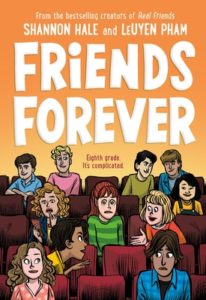 Comics
Comics
Shannon Hale and Leuyen Pham. Friends Forever. First Second
The sequel to Shannon Hale and LeUyen Pham’s best-selling graphic novels Real Friends and Best Friends is the confidently revealing memoir Friends Forever. The story is explicitly Mormon in its depiction of Shannon Hale’s memories of church culture, personal testimony, guilt and confusion, hope and faith, but not exclusively Mormon as the stories of awkward adolescence resonate beyond the experiences of members of The Church of Jesus Christ of Latter-Day Saints. Pham’s role in the graphic novel deserves particular praise, as the consistently strong artwork represents the best type of storytelling that comic books and graphic novels allow. The narrative is always clear, and smart choices in varying the art style alert the reader to flashbacks or internal narratives in the protagonist’s head ensure clarity of story. What is most impressive in this graphic novel memoir is the sense of honesty that permeates every page. The simultaneous and contradictory urges of a 13-year-old to both conform to and at times push against the cultural norms of her church-centered family resonate as true to Hale’s lived experience
Other finalists:
Mark Elwood. The Glass Looker: Collected Tales of Joseph Smith
Matt Page. Future Day Saints: The Gnomlaumite Crystal
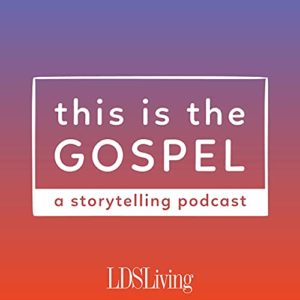 Podcast
Podcast
This Is the Gospel. LDS Living.
KaRyn Lay, host/producer/editor. Erika Free and Katie Lambert, producers/editors. Derek Campbell, mixer. Erin Hallstrom, executive producer.
This is the Gospel is a storytelling podcast sponsored by LDS Living, with a goal to collect and share personal stories that illustrate the challenges and triumphs of living in the latter days. And in presenting this podcast with the 2021 AML Award for Best Podcast, it is our pleasure to report that the content and delivery of these stories work together to create a beautiful work of Mormon art – a library of oral literature with great value.
It has been our judging panel’s pleasure to spend time over the preceding months with over 100 different podcasts initially in contention for this award. We have been inspired to see the breadth and depth of creation being done in this medium. And to a person we have felt daunted at the prospect of selecting one winner from among the sea of quality shows. In the end, This is the Gospel distinguishes itself not only for its unique attributes, but for its consistent quality in the many artistic and technical elements required when creating a podcast.
We give high praise to the team behind This is the Gospel for their diligence and discernment in sourcing raw material, by soliciting and screening story submissions from across the global Mormon diaspora. We are equally impressed by the editing and formatting done to prepare these stories for consumption and maximize their impact. The presence and performance of the women who produce and host the show – KaRyn Lay, Erika Free, and Katie Lambert – is frequently accretive and helps knit the stories to their themes, without becoming distracting. We also find the technical aspects of the show to be best-in-class. The audio quality, music, show notes, user interface, and other details are reflective of the obvious respect and reverence the creative team has for the stories they have been given
Other finalists:
Faith Matters
Latter-day Contemplation
Leading Saints
Sunstone Mormon History

I’m so very proud of Tatum’s work here. The summary/review is spot on and actually moving in and of itself. The general theme and certain aspects addressed in RedeemHER are rarely discussed in LDS circles. Thankfully our more open and self aware times make the messages within her play acceptable and refreshingly welcome. Refreshing because so many LDS and even others not of this faith relate to them.